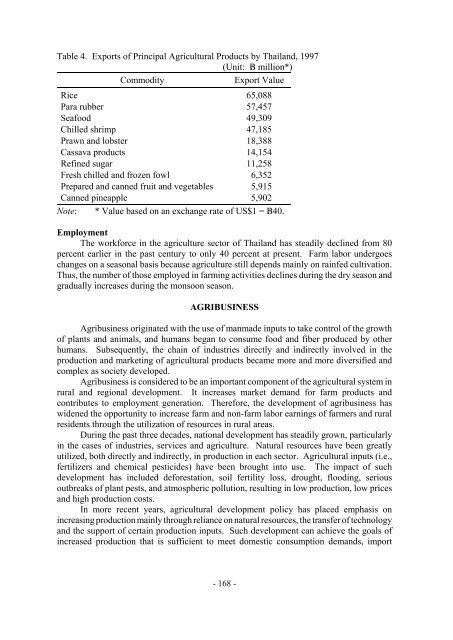Development of Agribusiness Enterprises - Asian Productivity ...
Development of Agribusiness Enterprises - Asian Productivity ...
Development of Agribusiness Enterprises - Asian Productivity ...
Create successful ePaper yourself
Turn your PDF publications into a flip-book with our unique Google optimized e-Paper software.
Table 4. Exports <strong>of</strong> Principal Agricultural Products by Thailand, 1997<br />
(Unit: B/ million*)<br />
Commodity Export Value<br />
Rice 65,088<br />
Para rubber 57,457<br />
Seafood 49,309<br />
Chilled shrimp 47,185<br />
Prawn and lobster 18,388<br />
Cassava products 14,154<br />
Refined sugar 11,258<br />
Fresh chilled and frozen fowl 6,352<br />
Prepared and canned fruit and vegetables 5,915<br />
Canned pineapple 5,902<br />
Note: * Value based on an exchange rate <strong>of</strong> US$1 = B/ 40.<br />
Employment<br />
The workforce in the agriculture sector <strong>of</strong> Thailand has steadily declined from 80<br />
percent earlier in the past century to only 40 percent at present. Farm labor undergoes<br />
changes on a seasonal basis because agriculture still depends mainly on rainfed cultivation.<br />
Thus, the number <strong>of</strong> those employed in farming activities declines during the dry season and<br />
gradually increases during the monsoon season.<br />
AGRIBUSINESS<br />
<strong>Agribusiness</strong> originated with the use <strong>of</strong> manmade inputs to take control <strong>of</strong> the growth<br />
<strong>of</strong> plants and animals, and humans began to consume food and fiber produced by other<br />
humans. Subsequently, the chain <strong>of</strong> industries directly and indirectly involved in the<br />
production and marketing <strong>of</strong> agricultural products became more and more diversified and<br />
complex as society developed.<br />
<strong>Agribusiness</strong> is considered to be an important component <strong>of</strong> the agricultural system in<br />
rural and regional development. It increases market demand for farm products and<br />
contributes to employment generation. Therefore, the development <strong>of</strong> agribusiness has<br />
widened the opportunity to increase farm and non-farm labor earnings <strong>of</strong> farmers and rural<br />
residents through the utilization <strong>of</strong> resources in rural areas.<br />
During the past three decades, national development has steadily grown, particularly<br />
in the cases <strong>of</strong> industries, services and agriculture. Natural resources have been greatly<br />
utilized, both directly and indirectly, in production in each sector. Agricultural inputs (i.e.,<br />
fertilizers and chemical pesticides) have been brought into use. The impact <strong>of</strong> such<br />
development has included deforestation, soil fertility loss, drought, flooding, serious<br />
outbreaks <strong>of</strong> plant pests, and atmospheric pollution, resulting in low production, low prices<br />
and high production costs.<br />
In more recent years, agricultural development policy has placed emphasis on<br />
increasing production mainly through reliance on natural resources, the transfer <strong>of</strong> technology<br />
and the support <strong>of</strong> certain production inputs. Such development can achieve the goals <strong>of</strong><br />
increased production that is sufficient to meet domestic consumption demands, import<br />
- 168 -
















